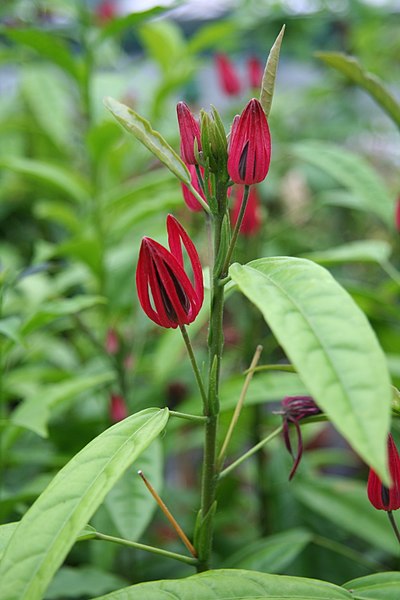
Pavonia multiflora

As we approach the frost-free date, I am planning the exciting tropicals I will be planting in the garden. I am excited to add the Brazilian candle plant, Pavonia multiflora for its dark green glossy foliage and bright pinkish-red bracts.
The flowering form of the Brazilian candle plant Pavonia multiflora is an anomaly within the genus and in the hibiscus family. Botanists often see things that others might miss. This plant does not appear at first glance to resemble Hibiscus by any stretch of the imagination, but the devil is in the details. Typically members of the genus Pavonia resemble swamp hibiscus flowers with wide petals and the fused column of filaments projecting from the center seen widely in members of the mallow family Malvaceae. Pavonia multiflora, however, has attractive, bright pinkish-red bracts that splay outward beneath tightly fused burgundy sepals that hold the rolled petals which protrude like a satiny, deep-purple cigar. From the center of the tube of petals emerges a spray of stamens with red filaments and tiny spherical blue anthers. Truly a very attractive flower and, thankfully, plentiful on the plant during the flowering period.
The genus name comes as a latinization in honor of José Antonio Pavón, 19th century Spanish botanist, who was famous for his explorations and botanizing in South America under the funding of Charles III of Spain. The species name means “many-flowered.” Pavonia multiflora is a naturally evergreen shrub with shiny, lance-shaped leaves and can reach heights of 8ft in the wild. Generally preferring part shade conditions, sources indicate that as a houseplant it will reach a maximum of about 3ft and responds well to periodic, hard cutbacks. This plant and many others will be available at the 2019 Scott Arboretum Selections Spring Sale on Saturday, May 11!





Eunice Silver
Posted at 18:20h, 29 AprilWintered over beautifully.
Doniczki
Posted at 01:53h, 14 MayIt’s actually a great fit in a pot 🙂